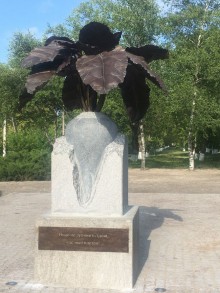Like in other populated areas, a monument to Vladimir Lenin was torn down as part of decommunization at the village of Pershotravneve, Vitovka raion, Mykolaiv oblast. But, in contrast to many other pedestals, this one did not remain empty – the Zasillia Sugar Mill erected a monument to… sugar beet here.
Volodymyr PALIIENKO, general manager of Ukrainian Sugar Company, the main initiator of the idea, told The Day that the desire to put up this monument had emerged as far back as 2012, but it was planned at the time to install it on the mill’s territory. “The crop that gives us business, glorifies Ukraine, and provides villagers with jobs, is very important to us. The mill’s output is the best in Ukraine now. We harvest 800 metric quintals of beetroots from a hectare of land. When ‘the fall of Lenin statues’ began, the monument, which stood in front of the mill’s office, was pulled down. I understood then that this should be put an end to in some way and finally implemented my idea. A Lviv sculptor worked on the monument. We changed the monument’s slabs, carved out root leaves, and gentrified the territory,” he said.
Paliienko pointed out that the phrase inscribed on the monument, “Nothing will stop the idea whose time has come,” which Mykolaiv residents discussed so lively in social websites, belongs to Stepan Bandera. “I thought the phrase was quite in place because the idea of growing [beetroots] had long been in the air and nobody could stop us. This is our company’s inner history,” he said.
The general manager of Ukrainian Sugar Company also told us about milestones in the enterprise’s history. The sugar mill has existed since 1965, but it had stayed idle for about 10 years until 2007, when the British company ED&F Man invested 144 million dollars in it. “We reconstructed the mill. First of all, we installed a special equipment to process cane sugar. The mill had once processed both sugar cane and beetroots. There were 192 sugar mills in Ukraine at the time. This country was one of the world’s Top 5 producers of sugar and beetroots (it produced six million tons of sugar a year). Today, there are 42-46 operational sugar mills in Ukraine,” Paliienko says. “In 2009-10, the mill began to process cane sugar. We’ve had an intention to resume growing beets in southern Ukraine since 2008. Many opposed this idea both inside the company and in Ukraine as a whole. Nobody in Ukraine believed that the only surviving sugar mill in the south would revive. Nor did our London-based company believe much in this. This stirred up a lot of disputes. We built a totally new mill in 2013, resumed the growing of beets, leased 13,000 hectares of land, and irrigated the land.”
In his turn, Pershotravneve village chief administrator Vasyl BELASHOV noted that “for the mill personnel, this monument is a symbol of development and prosperity. A few dozen years ago, the mill was on the rocks, but when it began to develop, people stopped leaving the village, found stable wages, and glorified Pershotravneve.”
In the view of Nadia IVANOVA, manager of the agrarian company Zolotyi Kolos, “the monument to beetroot fits the village very well. Besides, in addition to sugar beets, the crop rotation includes wheat, barley, soy, rapes, maize, sunflowers, and even flax. Ukrainian Sugar Company Ltd. has confirmed that the rural industry can bring Ukraine glory, significance, and revenues. The village is developing thanks to the sugar industry.”







